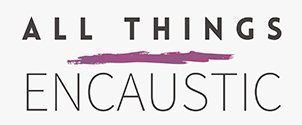There are different methods of working with encaustic wax to create art:
- In traditional Encaustic painting, encaustic paints are melted either on a hot palette or in small tins on a griddle. The encaustic paint is applied to an absorbent substrate such as a wood panel. Each layer is fused with a hot tool such as a blow torch, heat gun, iron or stylus.
- Encaustic Monotype printmaking involves drawing with solid pigmented encaustic blocks on a heated palette. The wax melts and is manipulated with tools. To create the print, paper is laid on the plate and the wax absorbs into the paper fibres. The artist applies gentle pressure with a Japanese baren. The paper is lifted off, creating a one-of-a-kind print.
- Three-dimensional encaustic sculptures – To create a 3-D encaustic sculpture the artist will create an armature structure using materials such as wire, wire mesh, plaster gauze and modelling paste. Paper, fabric or natural fibres are dipped into molten encaustic medium or the encaustic paints are brushed onto the skeletal form and fused.
- Iron Wax Painting involves melting pigmented blocks of wax directly on an encaustic iron. The iron, instead of brushes, is used as a tool to paint on cards or cardstock. An encaustic stylus with different nibs may also be used. Additional fusing is not required.
Cold wax painting is not encaustic as it does not use heat.

